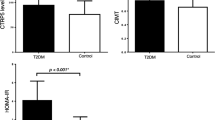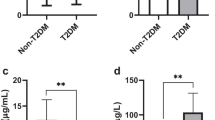Abstract
Aims
C1q/tumor necrosis factor-related protein-6 (CTRP6) is a novel adipokine and has emerged as an important mediator for lipid and glucose metabolism. However, to date, the relationship between CTRP6 and T2DM in humans has not been demonstrated. Our objective is to investigate the association of circulating CTRP6 with T2DM in a cross-sectional study.
Methods
118 patients with newly diagnosed T2DM, 98 subjects with impaired glucose tolerant (IGT) and 132 healthy subjects were recruited for this study. OGTT were performed in 48 healthy individuals to investigate the association of CTRP6 with glucose, insulin and other adipokines. Circulating CTRP6, TNF-α and Adipoq were measured by ELISA.
Results
IGT and T2DM individuals had higher serum CTRP6 levels than healthy controls (406.2 ± 136.6 and 539.1 ± 169.7 vs. 354.3 ± 117.2 ng/mL; both P < 0.01), whereas serum CTRP6 concentrations were further increased in T2DM patients compared with IGT individuals (P < 0.01). Serum CTRP6 levels were found to be related positively to BMI, WHR, FAT%, TC, TG, HbA1c, FBG, 2 h-OGTT, fasting insulin (FIns), 2 h-Ins, HOMA-IR and TNF-α, and negatively with HDL-C and Adipoq in all individuals (P < 0.05 or P < 0.01). Multivariate logistic regression analysis demonstrated that CTRP6 was correlated with both IGT and T2DM. After an oral glucose challenge, serum CTRP6 concentrations exhibited a similar change with blood glucose, insulin, TNF-α and Adipoq.
Conclusions
CTRP6 may be a metabolism- and nutrition-related adipokine and may be related to insulin resistance and T2DM.
Trial registrations
Clinical Trial Registration Number: ChiCTR-OCC-11001422. Registration name: Plasma cytokines and endothelial function in type 2 diabetes



Similar content being viewed by others
Abbreviations
- CTRP6:
-
C1q/tumor necrosis factor-related protein-6
- T2DM:
-
Type 2 diabetes mellitus
- IGT:
-
Impaired glucose tolerant
- NGT:
-
Normal subjects
- OGTT:
-
Oral glucose tolerance tests
- BMI:
-
Body mass index
- WHR:
-
Waist-to-hip ratio
- FAT%:
-
The percentage of body fat
- HDL-C:
-
High-density lipoprotein cholesterol
- TC:
-
Total cholesterol
- TG:
-
Triglyceride
- FBG:
-
Fasting blood glucose
- 2-h OGTT:
-
2-h blood glucose after glucose overload
- FIns:
-
Fasting insulin
- 2-hIns:
-
2-h plasma insulin after glucose overload
- HOMA-IR:
-
Homeostasis model assessment of insulin resistance
- Adipoq:
-
Adiponectin
- TNF-α:
-
Tumor necrosis factor-α
- AUCglucose :
-
The area under the curve for insulin
References
Luo L, Liu M (2016) Adipose tissue in control of metabolism. J Endocrinol 231(3):R77–R99
Liao WL, Lee WJ, Chen CC et al (2017) Pharmacogenetics of dipeptidyl peptidase 4 inhibitors in a Taiwanese population with type 2 diabetes. Oncotarge 8(11):18050–18058
Rasouli N, Kern PA (2008) Adipocytokines and the metabolic complications of obesity. J Clin Endocrinol Metab 93(1):64–73
Maury E, Brichard SM (2010) Adipokine dysregulation, adipose tissue inflammation and metabolic syndrome. Mol Cell Endocrinol 314(1):1–16
Polyzos SA, Kountouras J, Mantzoros CS (2016) Adipokines in nonalcoholic fatty liver disease. Metabolism 65(8):1062–1079
Lau WB, Ohashi K, Wang Y, Ogawa H, Murohara T, Ma XL et al (2017) Role of adipokines in cardiovascular disease. Circ J 81(7):920–928
Wong GW, Wang J, Hug C, Tsao TS, Lodish HF (2004) A family of Acrp30/adiponectin structural and functional paralogs. Proc Natl Acad Sci USA 101(28):10302–103027. https://doi.org/10.1073/pnas.0403760101
Wong GW, Krawczyk SA, Kitidis-Mitrokostas C, Revett T, Gimeno R, Lodish HF (2008) Molecular, biochemical and functional characterizations of C1q/TNF family members: adipose-tissue-selective expression patterns, regulation by PPAR-γagonist, cysteine-mediated oligomerizations, combinatorial associations and metabolic functions. Biochem J 416(2):161–177
Seldin MM, Tan SY, Wong GW (2014) Metabolic function of the CTRP family of hormones. Rev Endocr Metab Disord 15(2):111–123
Zheng Q, Yuan Y, Yi W et al (2011) C1q/TNF-related proteins, a family of novel adipokines, induce vascular relaxation through the adiponectin receptor-1/AMPK/eNOS/nitric oxide signaling pathway. Arterioscler Thromb Vasc Biol 31(11):2616–2623
Lei H, Wu D, Wang JY et al (2015) C1q/tumor necrosis factor-related protein-6 attenuates post-infarct cardiac fibrosis by targeting RhoA/MRTF-A pathway and inhibiting myofibroblast differentiation. Basic Res Cardiol 110(4):35
Chi L, Hu X, Zhang W et al (2017) Adipokine CTRP6 improves PPARγ activation to alleviate angiotensin II-induced hypertension and vascular endothelial dysfunction in spontaneously hypertensive rats. Biochem Biophys Res Commun 482(4):727–734
Wu W, Sun Y, Zhao C et al (2016) Lipogenesis in myoblasts and its regulation of CTRP6 by AdipoR1/Erk/PPARγ signaling pathway. Acta Biochim Biophys Sin (Shanghai) 48(6):509–519
Wu W, Zhang J, Zhao C, Sun Y, Pang W, Yang G (2017) CTRP6 regulates porcine adipocyte proliferation and differentiation by the AdipoR1/MAPK signaling pathway. J Agric Food Chem 65(27):5512–5522
Wu WJ, Mo DL, Zhao CZ et al (2015) Knockdown of CTRP6 inhibits adipogenesis via lipogenic marker genes and Erk1/2 signalling pathway. Cell Biol Int 39(5):554–562
Fan RH, Zhu XM, Sun YW, Peng HZ, Wu HL, Gao WJ (2016) CTRP6 inhibits fibrogenesis in TGF-β1-stimulated human dermal fibroblasts. Biochem Biophys Res Commun 475(4):356–360
Murayama MA, Kakuta S, Inoue A et al (2015) CTRP6 is an endogenous complement regulator that can effectively treat induced arthritis. Nat Commun 6:8483
Cooper JD, Smyth DJ, Smiles AM et al (2008) Meta-analysis of genome-wide association study data identifies additional type 1 diabetes risk loci. Nat Genet 40(12):1399–1401
Lei X, Seldin MM, Little HC, Choy N, Klonisch T, Wong GW (2017) C1q/TNF-related protein 6 (CTRP6) links obesity to adipose tissue inflammation and insulin resistance. J Biol Chem 292(36):14836–14850
Lee W, Kim MJ, Park EJ, Choi YJ, Park SY (2010) C1qTNF-related protein-6 mediates fatty acid oxidation via the activation of the AMP-activated protein kinase. FEBS Lett 584(5):968–972
American Diabetes A (2011) Diagnosis and classification of diabetes mellitus. Diabetes Care 34(Suppl 1):S62–S69
Li K, Xu X, Hu W et al (2014) Glypican-4 is increased in human subjects with impaired glucose tolerance and decreased in patients with newly diagnosed type 2 diabetes. Acta Diabetol 51(6):981–990
Matthews DR, Hosker JP, Rudenski AS, Naylor BA, Treacher DF, Turner RC (1985) Homeostasis model assessment: insulin resistance and β-cell function from fasting plasma glucose and insulin concentrations in man. Diabetologia 28(7):412–419
Li L, Miao Z, Liu R, Yang M, Liu H, Yang G (2011) 11 Liraglutide prevents hypoadiponectinemia-induced insulin resistance and alterations of gene expression involved in glucose and lipid metabolism. Mol Med 17(11–12):1168–1178
Ouchi N, Kihara S, Funahashi T, Matsuzawa Y, Walsh K (2003) Obesity, adiponectin and vascular inflammatory disease. Curr Opin Lipidol 14(6):561–566
Kadowaki T, Yamauchi T, Kubota N, Hara K, Ueki K, Tobe K (2006) Adiponectin and adiponectin receptors in insulin resistance, diabetes, and the metabolic syndrome. J Clin Investig 116(7):1784–1792
Yang M, Liu R, Li S et al (2013) Zinc-α2-glycoprotein is associated with insulin resistance in humans and is regulated by hyperglycemia, hyperinsulinemia, or liraglutide administration: cross-sectional and interventional studies in normal subjects, insulin-resistant subjects, and subjects with newly diagnosed diabetes. Diabetes Care 36(5):1074–1082
Hu W, Li L, Yang M et al (2013) Circulating Sfrp5 is a signature of obesity-related metabolic disorders and is regulated by glucose and liraglutide in humans. J Clin Endocrinol Metab 98(1):290–298
Ouchi N, Parker JL, Lugus JJ, Walsh K (2011) Adipokines in inflammation and metabolic disease. Nat Rev Immunol 11(2):85–97
Kim MJ, Lee W, Park EJ, Park SY (2010) C1qTNF-related protein-6 increases the expression of interleukin-10 in macrophages. Mol Cells 30(1):59–64
Acknowledgements
This work was supported by Grant 2017MSXM20 and 2016MSXM083 from the Science and Technology key Program of Health Bureau of Chongqing, China.
Author information
Authors and Affiliations
Contributions
GY and XZ designed this research (included project conception, development of overall research plan); XT, MW and WD supervised the studies, contributed to the discussion, and revised/edited the article. DL and HL collected the data and conducted the research; HZ provided essential reagents; LL, XZ interpreted the data and drafted the article; GY had primary responsibility for final content. All authors read and approved the final manuscript.
Corresponding authors
Ethics declarations
Conflict of interest
The authors declare that there is no duality of interest associated with this manuscript. The authors declare no conflict of interest.
Statement of human rights
All procedures performed in studies involving human participants were in accordance with the ethical standards of the institutional and/or national research committee and with the 1964 Helsinki declaration and its later amendments or comparable ethical standards.
Informed consent
Informed consent was obtained from all individual participants included in the study.
Additional information
Managed by Massimo Porta.
Rights and permissions
About this article
Cite this article
Wang, M., Tang, X., Li, L. et al. C1q/TNF-related protein-6 is associated with insulin resistance and the development of diabetes in Chinese population. Acta Diabetol 55, 1221–1229 (2018). https://doi.org/10.1007/s00592-018-1203-2
Received:
Accepted:
Published:
Issue Date:
DOI: https://doi.org/10.1007/s00592-018-1203-2




